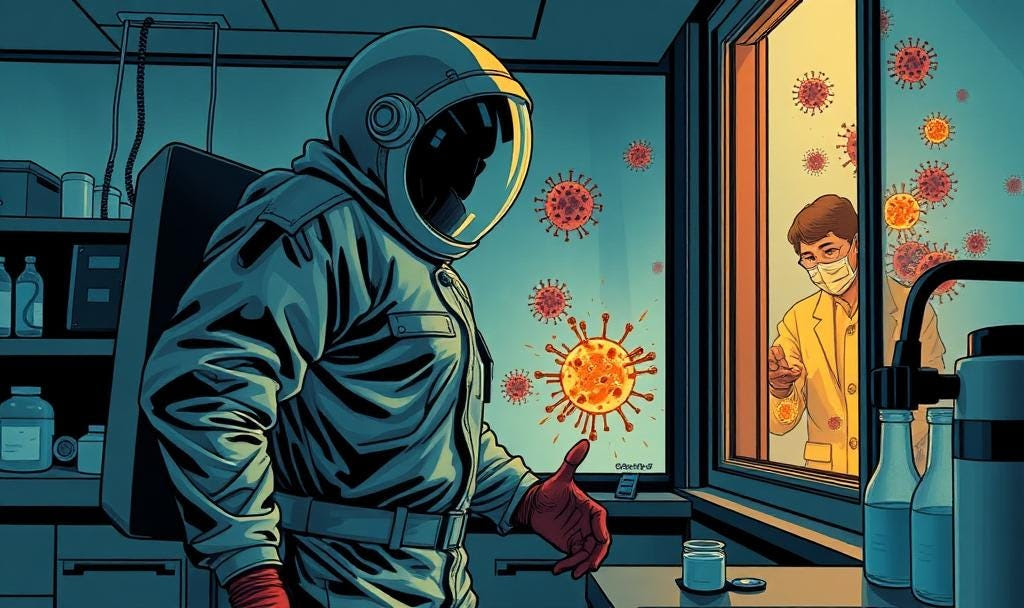
- Details
- By Professor Victoria Sutton
Guest Opinion. The most secure biological laboratory for the most dangerous pathogens may have been the scene of a federal biological crime.
The U.S. Army Medical Research Institute of Infectious Diseases (USAMRIID) at Ft. Detrick is the major military laboratory of the U.S. Army and the only BSL-4 level laboratory, operating from before biological weapons were made illegal by the Biological Weapons Convention (BWC) of 1975. The Laboratory transitioned to peacetime research strictly limited to defensive work, which is legal under the Treaty. Nearby on the same campus sits the National Institutes of Health biocontainment laboratory, that is operated by a contractor, Battelle Laboratories, doing work for the National Institution of Allergy and Infectious Diseases.
Who is in charge of inspections of these high containment labs?
The Centers for Diseases Control and Prevention (CDC) is the lead inspection agency in partnership with USDA when it involves animal testing. They implement the regulatory program for safety and security of biological agents that have met a threshold of risk, requiring extensive oversight of the laboratory. CDC has the power to shut down laboratories that are in non-compliance. CDC also inspects the USAMRIID military laboratory following a similar regulatory framework that mirrors the civilian one.
There are only two civilian high level biocontainment laboratories — the Univ of Mass-Boston Laboratory; and the UTMB Laboratory. The Battelle Laboratory is the NIAID government laboratory (civilian) integrated with the U.S. Army facility (USAMRIID). In addition, USDA had the Plum Island facility for animal research which was transferred to the Department of Homeland Security when it was created. It was closed, and a new animal biodefense laboratory was built at the Univ of Kansas in Manhattan, Kansas.Biocontainment Laboratories in the U.S.
Biocontainment Laboratories in the U.S.
There are four levels of biocontainment laboratories:
The four biosafety levels are BSL-1, BSL-2, BSL-3, and BSL-4, with BSL-4 being the highest (maximum) level of containment.³There are additional specific rules and designations for animal research (ABSL), agricultural research (BSL-Ag), and other types of research. While we have a good idea of the number of BSL-4 and ABSL-4 laboratories; no one really knows how many BSL-3 laboratories exist in the U.S., which includes private sector laboratories. There is no registration requirement for these laboratories unless they are handling biological agents specifically listed for regulation. So while the focus is on the most highly regulated biocontainment laboratories, there are plenty of other laboratories that may have accidents that go unnoticed.
Inspections of the U.S. Army Medical Research Institute of Infectious Diseases (USAMRIID)
As is usually the case, you can look at a pattern of non-compliance preceding a shutdown. Just within the last six years, in 2019, the entire laboratory was shut down by CDC for failure to adequately meet the standards of waste water treatment, which potentially sends bacteria and virus laden water into the surrounding surface water and environment. They successfully met the standard in 2020.
National Institute of Allergy and Infectious Diseases (NIAID) Integrated Research Facility at Fort Detrick (IRF-Frederick)
The NIAID, the infectious disease research arm of the National Institutes of Health, has a laboratory integrated with USAMRIID. They share some of the facilities like the imaging device for animals. The Integrated Research Facility was shut down due to potential contractor misconduct that may have put the security at risk at the facility, according to an email from Michael Holbrook, associate director for high containment on April 29, 2025.
Crimes and Personal Injury claims for Disease transmission
The most common case of disease transmission, either intentionally or recklessly, is for STDs, HIV or other sexually transmitted disease. Recovery can be up to $1million for injury. Some states have even criminalized the transmission of HIV or engaging in behavior that could transmit HIV; however, there is a trend toward decriminalizing the passive transmission of HIV.
In April 29, 2025, the laboratory was shut down due to safety concerns. The worst type of safety concerns are not equipment or facilities but the humans safety culture within them. In this incident causing the shut-down, two purportedly ex-lovers engaged in deadly behavior to attempt to cause the infection of the other by a deadly biological disease, Ebola. Members of Congress from Maryland, the location of the laboratory, asked for a report on the incident with a letter dated June 10, 2025 by June 17, 2025. Because this is now a federal investigation (not a military one, or a civilian one), it is unlikely we will learn anything further. However, we can speculate about what federal crimes may have been committed.
The potential federal crimes
Suspects often lie when they are interviewed by the FBI which is an easy Sec. 1001 felony — making any “materially false statement . . .” . " within the “jurisdiction” of any branch of government. If the lie involves “domestic terrorism” the penalty can be five years in prison.
The most analogous crime are those cases involving a plot to use ricin to murder a spouse. Ricin is a potential biological weapon, and it is illegal to possess it. It is made from castor beans and can be isolated using a kitchen, or purchased on the dark web. Penalties for a plot to use a biological weapon can result in life in prison; while successfully carrying out a plot to use a biological weapon can result in the death penalty. Further, attempted murder is always a choice or additional count.
If they were working at level 4 with the Ebola virus, with a 90% fatality rate when untreated, would tend toward evidence for an attempted murder count.
Since this is the civilian side of the laboratories on this campus, there is no court-martial option. When the FBI are called to investigate, that means the National Counterterrorism Center (NCTC) has determined this is a likely bioterrorism event and so there is federal jurisdiction. That gives us some insight into the nature of the security breech.
The Biological Weapons Anti-Terrorism Act of 1989 (BWATA) was passed in part to comply with our obligations under the Biological Weapons Treaty. This statute prohibits the creation, possession or transfer of any biological weapon at 18 USC Sec. 175.
The Anti-Terrorism and Effective Death Penalty Act of 1996 makes it a crime for anyone who “attempts, threatens, or conspires” to use a biological weapon. Possession of a “weapon of mass destruction” used against a “person” in interstate commerce (or would have affected interstate commerce) is a crime at 18 U.S.C. 2332a. A “weapon of mass destruction” is defined as:
(2) the term “weapon of mass destruction” means— (A) any destructive device as defined in section 921 of this title ; (B) any weapon that is designed or intended to cause death or serious bodily injury through the release, dissemination, or impact of toxic or poisonous chemicals, or their precursors; (C) any weapon involving a biological agent, toxin, or vector (as those terms are defined in section 178 of this title ); or (D) any weapon that is designed to release radiation or radioactivity at a level dangerous to human life; and
So the criteria for substantially affecting “interstate commerce” is a fairly low bar standard and has been met by requiring investigators to travel to the site and spend money at hotels and restaurants to meet this criteria.
These laws make it a crime to actually successfully use ricin in a plot, but must also include a political motive:
The Violent Crime Control and Law Enforcement Act of 1994 amends the Antiterrorism Act of 1990 to include biological agents, which includes ricin.
The USA Patriot Act of 2001 also amends the Antiterrorism Act of 1990 and adds domestic terrorism. However, domestic terrorism is defined to include a political motive, which would not include the crime of a spouse trying to murder their partner.
State criminal laws can still be applied — murder, attempted murder, conspiracy to murder, or depending on the facts, assault or battery may also be among the counts. These do not require a political motive, but do require intent to commit the crime and to murder their spouse, for example.
We will be waiting to see if there is an indictment from this incident; however, there is also a good chance it may be sealed and we will have to wait several years to see it.
Plot for a movie
In 2014, I watched fifty bioterrorism movies and analyzed the legal issues for a book entitled, The Things that Keep Us Up at Night: Reel Bio Terror. These movies involved widespread armageddon-style harm, and did not use a traditional lover’s quarrel plot. In Outbreak (1995), there was a moment when one of the character’s biosuit rips and everyone knows at that moment, a deadly infection will follow.
We do not yet know the nature of the incident, but it has been discussed in Senate Committee testimony, several media sources and in an email from a Director of the facility, indicating a personnel misconduct issue was to blame for the security breech that led to the shutdown.
This story may be a movie, yet.
CORRECTION: An earlier version of this column listed Battelle laboratories as a contractor. Battelle is not the contractor for the Integrated Research Facility where this incident is said to have occurred.
To read more articles by Professor Sutton go to: https://profvictoria.substack.
Professor Victoria Sutton (Lumbee) is Director of the Center for Biodefense, Law & Public Policy and an Associated Faculty Member of The Military Law Center of Texas Tech University School of Law.
Help us defend tribal sovereignty.
At Native News Online, our mission is rooted in telling the stories that strengthen sovereignty and uplift Indigenous voices — not just at year’s end, but every single day.
Because of your generosity last year, we were able to keep our reporters on the ground in tribal communities, at national gatherings and in the halls of Congress — covering the issues that matter most to Indian Country: sovereignty, culture, education, health and economic opportunity.
That support sustained us through a tough year in 2025. Now, as we look to the year ahead, we need your help right now to ensure warrior journalism remains strong — reporting that defends tribal sovereignty, amplifies Native truth, and holds power accountable.
 The stakes couldn't be higher. Your support keeps Native voices heard, Native stories told and Native sovereignty defended.
The stakes couldn't be higher. Your support keeps Native voices heard, Native stories told and Native sovereignty defended.
Stand with Warrior Journalism today.
Levi Rickert (Potawatomi), Editor & Publisher

